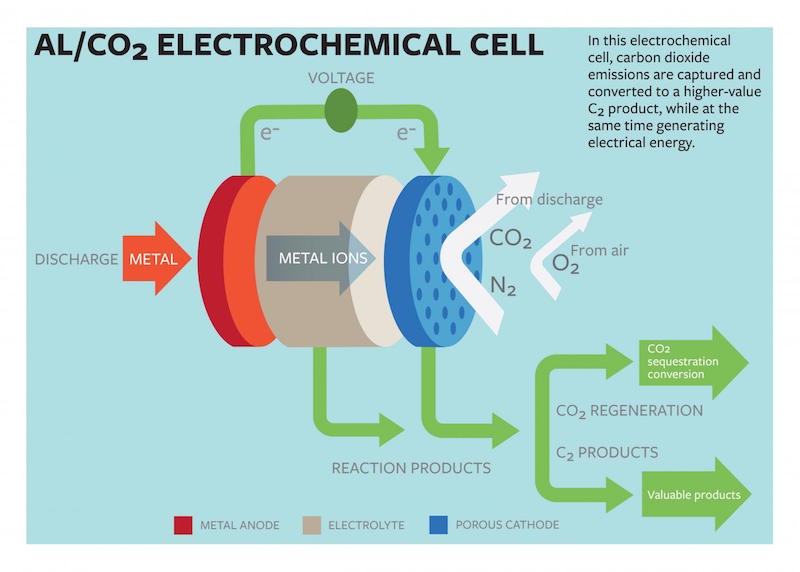
Features
Articles
Cornell scientists convert CO2 and create electricity
August 11, 2016 | By Anthony Capkun

August 11, 2016 – The field of carbon capture—chemically trapping CO2 before it is released into the atmosphere—continues to advance, as Cornell University recently researchers disclosed a method for capturing the greenhouse gas and converting it into a useful product for industry… while producing electrical energy.
Lynden Archer and Wajdi Al Sadat have developed an oxygen-assisted aluminum/carbon dioxide power cell that uses electrochemical reactions to both sequester the CO2 and produce electricity.
The team’s proposed cell would use aluminum as the anode and mixed streams of CO2 and oxygen as the active ingredients of the cathode. The electrochemical reactions between the anode and cathode would sequester the CO2 into carbon-rich compounds while producing electricity and an oxalate as a by-product.
In some carbon-capture models, the carbon is captured in fluids or solids, which are then heated or depressurized to release the CO2, explains Cornell. The concentrated gas must then be compressed and transported to industries that are able to reuse it, or sequestered underground.
The findings in the Cornell researchers’ study represent a possible paradigm shift, Archer said.
“The fact that we’ve designed a carbon capture technology that also generates electricity is, in and of itself, important,” he said. “One of the roadblocks to adopting current [CO2] capture technology in electric power plants is that the regeneration of the fluids used for capturing [CO2] utilize as much as 25% of the energy output of the plant. This seriously limits commercial viability of such technology. Additionally, the captured [CO2] must be transported to sites where it can be sequestered or reused, which requires new infrastructure.”
The group reports their electrochemical cell generated 13 ampere hours per gram of porous carbon (as the cathode) at a discharge potential of around 1.4 volts.
Another key aspect of their findings, Archer explained, is in the generation of superoxide intermediates, which are formed when the dioxide is reduced at the cathode. The superoxide reacts with the normally inert CO2, forming a carbon-carbon oxalate that is used in industries such as pharmaceutical, fiber and metal smelting.
“A process able to convert [CO2] into a more reactive molecule such as an oxalate that contains two carbons opens up a cascade of reaction processes that can be used to synthesize a variety of products,” Archer said, noting the configuration of the electrochemical cell depend upon the product one chooses to make from the oxalate.
This technology in not just limited to power plant applications, said Al Sadat. “It fits really well with onboard capture in vehicles, especially if you think of an internal combustion engine and an auxiliary system that relies on electrical power.”
He said aluminum is the perfect anode for this cell, as it is plentiful, safer than other high-energy density metals and lower in cost than other potential materials (e.g. lithium, sodium) while having comparable energy density to lithium. He added that many aluminum plants are already incorporating some sort of power-generation facility into their operations, so this technology could assist in both power generation and reducing carbon emissions.
A current drawback of this technology is the electrolyte (the liquid connecting the anode and cathode) is extremely sensitive to water. Ongoing work is addressing the performance of electrochemical systems and the use of electrolytes that are less water-sensitive.
— With files from Melissa Osgood. Image courtesy Cornell University.
Print this page